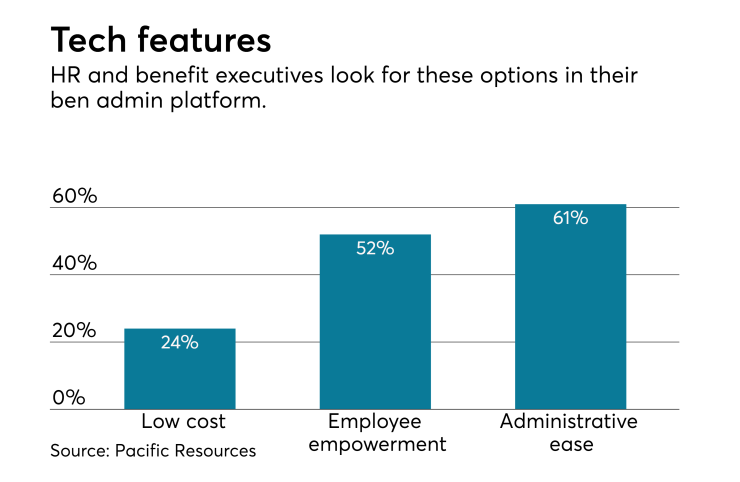Cost isn’t the primary driver for assessing strategic health and welfare benefits administration and HR technology platforms, suggests a recent survey of 91 senior HR and benefits executives from primarily Fortune 1000-ranked companies.
In fact, it plummeted to just 23.9% of respondents this year from as many as 64.4% last year. The survey conducted by brokerage Pacific Resources, which provides employers with an independent assessment of technology options, noted the importance of a more holistic approach.
Leading the charge were administrative ease at 61.4%, which was up from 38% in 2016, and empowering employees to make informed benefits decisions at 51.5%, which was up from 24.4% in 2016.

What the findings suggests to Chris Judd, EVP of Pacific Resources, is that employers “want employees to understand their benefits better, and for the first time, they’re feeling like there are tools and platforms available that can deliver that experience.” He noted a growing emphasis on self-service tools to select the right benefits.
Employees are starting to see the value in everything from sophisticated avatars and the cloud-based design to more complicated algorithms, according to Judd. And by integrating a technology platform with data warehousing, he says it creates “the best possible tools to make an educated decision” about the benefits package.
Also see: “
Among the top outcomes the survey respondents have found with
In addition, 88.8% felt that guided decision support, cost calculators and plan comparison tools were at least somewhat effective, while 83.2% indicated that communication, employee education and engagement are integral to overall benefits delivery.
Rapid changes
A key takeaway for benefit brokers and advisers is to understand the technology that’s available in the marketplace and how rapidly it’s changing, Judd observes. The research findings show that many employers are eager to make a move. For example, fewer than half of survey respondents said they were likely to remain with their current benefit platform vendor.
There’s also “a real opportunity to educate employers on what might be available,” he says, noting that only about 40% of the respondents said they had a thorough understanding of exchanges and just a quarter of them understood the fees.
Moving forward, Judd believes “it’s going to be increasingly difficult to be a benefits broker or consultant and not have an understanding of the technology aspect. They’re becoming so intertwined that you have to know the technology well to understand which benefits you can and can’t put on a platform and what the limitations might be.”





